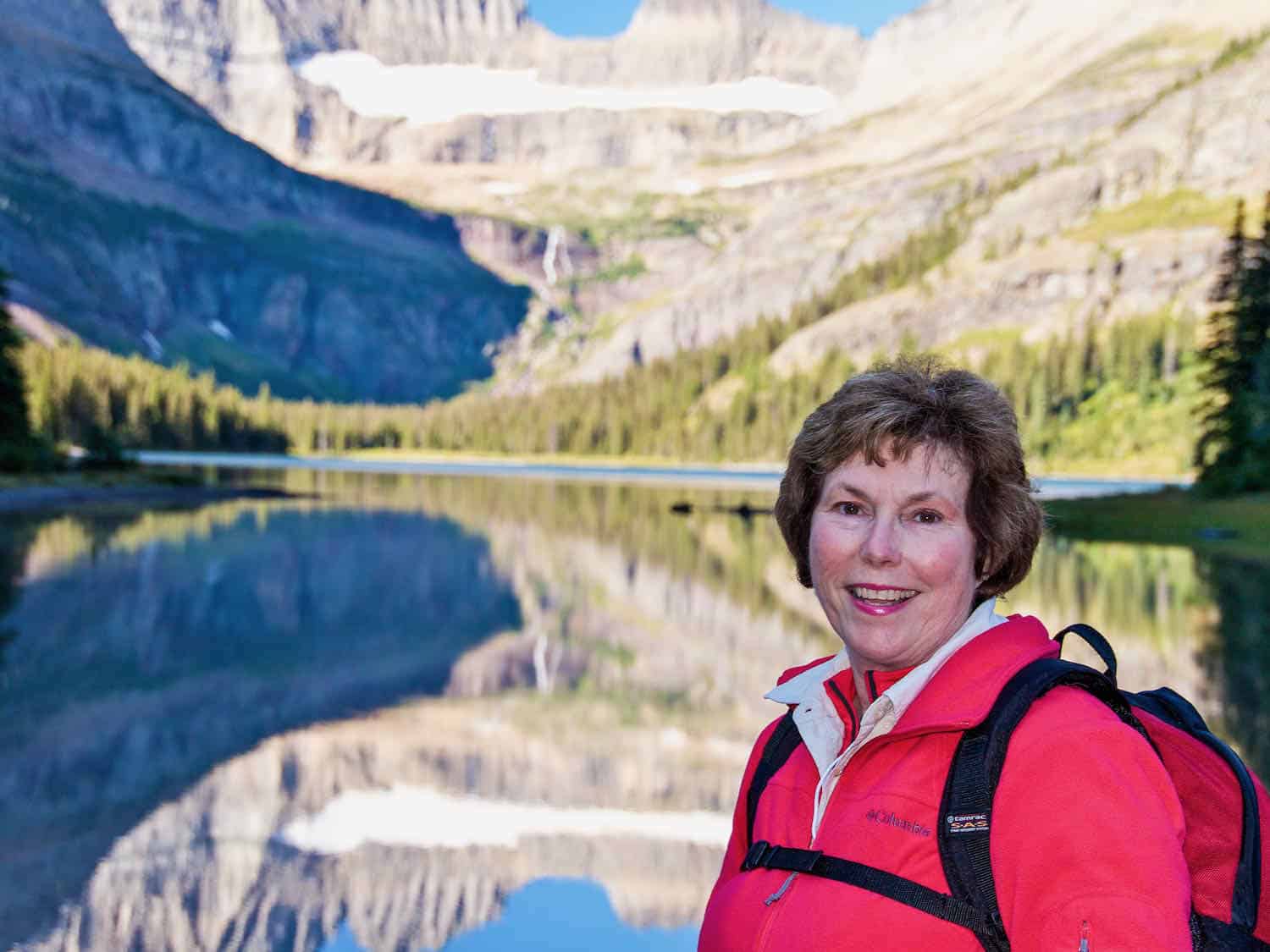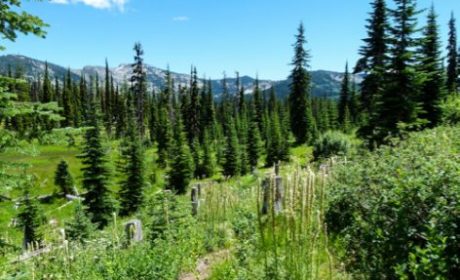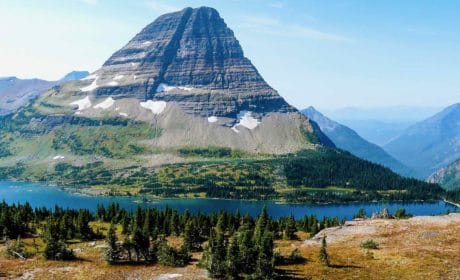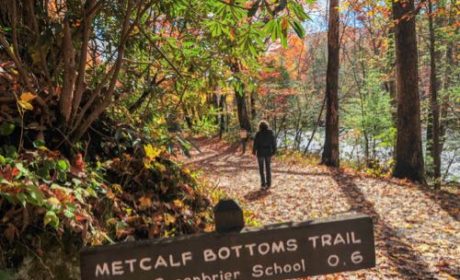Are you including day hikes in your next road trip, national park adventure, or cruise excursion? If so, you’re going to need my tips for day hiking essentials.
I’m a boomer traveler who still enjoys hiking. Alan, too.
We’re convinced that getting out on the trail is one of the best ways to experience a destination. Although Alan and I aren’t hardcore backpackers, show us a day hike or scenic short trail to include on a road trip or national park visit and we’re happy boomer travelers.
I’ve experienced some spectacular USA hikes, as well as international ones, over the years. There’s something about putting my feet on the ground that connects me to a place, not to mention that it’s good exercise for my boomer body.
As you begin packing for a trip that includes day hikes, do you find yourself wondering, “how much hiking equipment is too much?” or “which hiking clothes should I pack?”
If those questions are running around in your mind, my day hiking essentials tips will help you decide what to bring on a short hike and what to leave at home.
Table of Contents
My favorite day hiking essentials

Knowing what to bring on a day hike makes a huge difference in your hiking experience. Should you pack a heavy backpack filled with every hiking essential or choose a minimalist approach? Knowing the best hiking clothes to wear and equipment to pack is crucial to a good hiking experience.
How do I travel light, yet include the essentials for a day hike? Check out my hiking checklist for day hikers:
1. What to wear on a day hike: tops and pants

I’m a big believer in layering for a comfortable day on the trail. It’s my best tip for what to wear hiking.
Yes, you could wear a pair of jeans, but you’ll be sorry if it rains. Jeans take forever to dry out! Ask Alan—he doesn’t always follow my “what to wear for hiking” advice.
Pants for hiking:
Zip-off pants are indispensable on any hiking trip. That’s why I pack several pair of convertible hiking pants from Columbia. These aren’t your baggy convertible pants from a couple of years ago.
I also like the Saturday Trail stretch pants which are stylish enough to wear around town. And, yes, they come in plus sizes.
If the word “stretch” concerns you, REI offers more relaxed styles. Looking for men’s convertible hiking pants? Here you go.
Tops for hiking:
For up top, Alan and I wear sunshield long sleeve shirts. If we can find them with insect shield, even better.
In cooler weather, I’ll layer on a sleeveless quilted vest or a long-sleeve fleece jacket (and here’s a longer version of the fleece jacket.)
For a slightly heavier jacket that also provides protection from the elements, I recommend Kirkland Signature Ladies’ Water-repellent Wind Resistant Softshell Jacket. I own the red and blue versions of this coat—remember my tip to wear bright colors for better looking photos.
I look for tops and jackets with pockets that zip and are easy to access. This is where I keep my iPhone just in case an animal sighting occurs and I don’t have time to pull out the good camera from the backpack. And there are times, these days, when I don’t even bring a camera, relying on the iPhone instead.
2. Staying dry on short hikes
What if it rains? A raincoat and pants help you stay comfortable, warm and—most importantly—dry. I look for a brand that’s highly breathable so that I don’t suffocate if the weather’s warm, humid, or my body heats up from exertion.
Alan and I bought our rain gear from REI (they have petite and plus sizes in the pants, ladies) before a trip to Glacier National Park where we hiked 30 miles of day hikes in a week.
Here’s a packing light tip: I wear the rain pants over thermals and convertible pants on our trips to Antarctica and the Arctic.
3. Taking care of your head, hands and feet

For me, keeping head, hands and feet comfortable is the key to a happy hike. As long as I’m shielded from the sun, my hands aren’t cold and my feet are comfortable, I’m good to go.
Hiking gear for your head:
Since I’ve experienced skin cancer, a hat is a must for me—Alan, too. That’s why we both wear a Tilley Endurables Hat, which protects our faces from the sun. This Tilley hat also has a mesh feature for keeping our heads from getting too hot.
And here’s a tip for ladies who have curly hair—like me: wearing a hat, even if it’s a ball cap keeps hair under control and less frizzy.
Hiking gear for your hands:
If your hands get cold easily, like mine do, glove liners are a good choice for those cool mornings on the trail. Of course you want to bring a heavier pair of gloves if hiking in colder weather.
And, since you never know about the weather, tuck several packages of adhesive body warmersinto your pack. They come in varieties for hands, toes, feet and more. It’s your insurance against cold hands and feet on early spring or late fall hikes.
Hiking gear for your feet:
It goest without saying that comfortable hiking shoes are a must for day hikes. Alan and I wear Keene hiking boots—I like this one—for tough, rocky trails. But if we’re hiking a short trail while taking a break on road trips, we both wear lighter weight hiking shoes that can double as active wear shoes for the trip.
I’m a big fan of the Kuru Chicane. It’s a comfortable shoe with tread that grips the trail, without being a heavy hiking shoe. I pack the Kuru Chicane for cruises where shore excursions include hiking. And they look good enough to wear around town and double as my active wear shoe for on the ship.
Boomer Travel Tip
Check out my tips for the best cold weather gear for women that packs light.
This lightweight addition to my hiking gear is one of my favorites: gaiters. Depending on your hiking route’s terrain and weather conditions, a good pair of gaiters help protect your legs from getting wet. Wear them over waterproof hiking boots on a snow trip and you have snow boots without the bulkiness.
Of course great hiking socks are the key to comfortable fitting hiking shoes. Alan and I both wear Merino Wool Hiker Socks or Darn Tough Socks to keep our feet dry.
Good hiking socks also provide cushioning on a long day of exploring. Shh, don’t tell anyone, but I sometimes wear these around the house as bedroom shoes.
4. Hiking equipment for day hikers: what to bring on a short hike

An enjoyable hiking experience is more than the beauty of the trail or the comfort of the hiking clothes that you’re wearing. Day hikes and short hikes don’t require a lot of gear, but bringing along the right gear makes a big difference in the quality of your hiking experience.
Anti-shock hiking sticks are my best friend on the trail. They take the pressure off knees and hips, especially on downhill treks.
I also find that the poles help when my fear of heights kicks in. They keep me feeling steady and secure.
Yes, according to TSA, you can bring them on a flight as long as the hiking poles are packed in checked luggage.
How do we carry gear on a day hike? Alan and I avoid backpacks whenever possible because they’re hard on our boomer backs. For short hikes, our choice is to wear a waterproof fanny pack that holds a water bottle on each side of the pack.
However when we’re hiking in destinations where the weather changes quickly, a day hiking backpack like the Osprey Tempest for women or the Osprey Talon for men, is essential for holding rain gear or an extra layer of clothing.
Boomer Travel Tip
Need tips for getting out on the trail? I’ve written a hiking planner to help boomer travelers prepare for the best day hikes. Check it out!
For me, the best hiking day pack conforms to my body. It also includes cushioning on shoulder straps and comfortable hip belts that distribute the pack’s weight.
You’ll also need a backpack to carry larger cameras. Hiking with a camera around your neck is cumbersome and no fun—I know.
If you’re really picky about water quality, LifeStraw bottles have a two-step filtration system. Don’t just use them on a hike, these are great for air travel or running around town.
What about mosquitos and other pesky biting insects? Deet bug spray will protect you against mosquitos (and ticks), but what if you are trying to avoid chemical sprays?
I recommend a net that goes over your head that will protect your head, face and neck. Mosquito coil bracelets that contain essential infused oils that repel insects are another choice. Wear them on your arms and ankles to be completely protected. They come in a resealable pouch and last for 10 days or 250 hours of use.
And, just in case, pack this lightweight outdoor first aid kit. You’ll be happy that you did if a shoe causes a blister or another minor emergency occurs.
If you follow my day hiking gear list, you’ll be set with the best hiking gear for short hikes. These items also make the great gifts for hikers on your gift giving list.
Day Hiking Essentials Shopping List
Would you rather purchase day hiking essentials all in one place? This Amazon shopping list makes it easy for you to buy what you need to be out on the trail in no time. Happy shopping!

Columbia Women's Benton Springs Full Zip Jacket, Soft Fleece with Classic Fit
A fleece jacket is perfect when your day hike begins on a cool spring or fall morning. Once you warm up, tie the jacket around your waist. That's what I do. It's also lightweight enough to easily stuff into a backpack. Buy one of the bright colors so your photo stands out from trail scenery.

Kirkland Signature Ladies' Water-Repellent Wind Resistant Softshell Jacket
This Kirkland jacket comes in many colors (I don't recommend black if you'll be wearing this in photos). I wear my red Kirkland Signature jacket on almost every adventure. The lining adds a bit of warmth, plus the outer shell is water repellent and wind resistant.

Waterproof Hiking Fanny Pack
How do we carry gear on a day hike? For short hikes, our choice is to wear a waterproof fanny pack that holds a water bottle on each side of the pack.

BAFX Adjustable Anti Shock Aluminum Hiking Poles for Walking or Trekking
Hiking poles take the pressure off hips and knees, especially on downhill portions of the trail. If you have a fear of heights, like me, hiking sticks offer stability and security.

HotHands Toe, Hand and Body Warmer Variety Pack
Your hands and toes will thank you for carrying adhesive warmers in your pack. They're perfect for when colder weather surprises you on the trail.

Osprey Packs Tempest Women's Hiking Backpack
The Osprey Tempest comes with cushioned shoulder pads and comfortable hip belts. It's my backpack choice for day hikes where I need to pack more gear in anticipation of changing weather conditions.

Tilley Endurables LTM6 Airflo Hat
My Tilley Endurables hat protects me from the sun, plus the mesh airflo vent keeps my head from overheating.

KEEN Women's Targhee Waterproof Hiking Boots
For rocky trails, I wear a tough hiking boot like the Keene Targhee.

Darn Tough Vermont Hiker Boot Full Cushion Sock
Darn tough cushion socks keep my feet dry and comfortable. Good hiking socks provide essential cushioning for those long days of exploring.

Columbia Women's Standard Saturday Trail II Convertible Pant, British Tan, 6 Regular
These stretch hiking pants look good enough to wear around town. The convertible feature is handy for warmer days. And, ladies, these Columbia pants also come in plus sizes.

LifeStraw Go Water Filter Bottle
The LifeStraw has a 2-stage integrated filter that protects against, microplastics, chlorine, organic chemical matter and sand, dirt, cloudiness and more. And your water will taste better, too!

HESTYA 4 Pack Mosquito Head and Face Netting
Avoid mosquito and insect bites with the Hestya mosquito head and face netting. Place the head netting over a hat and your neck and face will be protected. Comes in a set of four. This is perfect if you only occasionally hike in mosquito prone areas. Also easy to pack in your luggage.

Cliganic 10 Pack Mosquito Repellent Bracelets
Wear these DEET-free mosquito repellent bracelets on your wrists and ankles to avoid bug bites on the trail. Each coil is individually wrapped in a reusable pouch. The essential-oil infused coils last for 10 days or 250 hours.
Need more what to wear on a trip tips?
- Read my advice on what to pack for an Alaska cruise.
- Discover cold weather gear that’s easy on the budget and packs light.
- Learn what to pack for a luxury cruise.
Save to Pinterest




